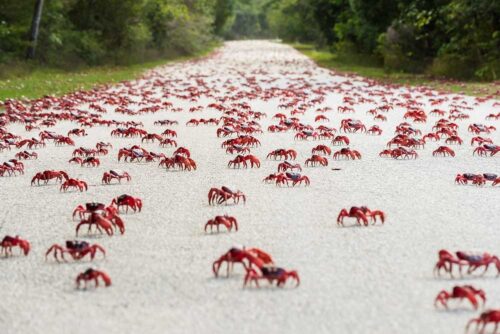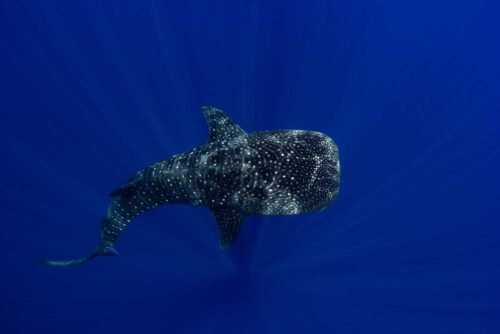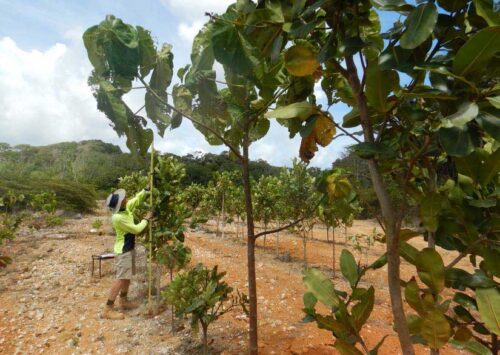Located in the Indian Ocean approximately 2,650 kilometres northwest of Perth and 500 kilometres south of the Indonesian capital, Jakarta. Christmas Island boasts some of the most fascinating and unique ecosystems on earth. The island is an Australian non-self-governing territory known for its biological diversity, providing habitat for endangered, threatened and migratory species as well as endemic species.
As an isolated oceanic island, distant from other land masses, Christmas Island is home to a high proportion of endemic species, some of them endangered. The National Park protects much of the island’s uniquely structured rainforests, two wetlands of international importance, tens of millions of red crabs. The Island is the only nesting place for the endangered Abbott’s booby and critically endangered Christmas Island frigatebird, and the wide range of other endemic species makes the island of significant interest to the scientific community.
The Christmas Island National Park currently protects 85 square kilometres, over 63% of the entire land and much of the fringing reef. The park protects and preserves the important ecological systems which characterise the island: the magnificent rainforests, the ocean shores and reefs. Furthermore 75% of the original vegetation on the island remains, which is quite amazing in itself, given the Island has been mined for phosphate for over 120 years. It’s what brought people to the Island in the first place.
PRL Group has a deep respect and appreciation for the environment and is committed to ensuring that Christmas Island’s rich bio-diversity is protected. Our workforce has lived on the island for four to five generations, it is their home. This has contributed strongly to our ethos of caring for and protecting the Island’s environment.
As part of our commitment to the environment, the company has put in place numerous programs and has invested millions, to help protect and care for the environment on Christmas Island.
Environmental Activities
-

At the start of the wet season upwards of 50 million red crabs begin their mass migration, marching from the forests to the coast to breed and lay their eggs. Often hailed as one of the world’s most impressive wildlife migrations; the eggs are only released by the females in conjunction with a precise lunar phase and at the turn of the high tide. At this time, the sea level at the base of the cliffs and on the beaches, where the eggs are released has the least amount of variation allowing for the safe release of eggs. There may be fluctuations in the time of year of the migration but all migrations retain the same lunar harmony. After about a month at sea, the baby crabs return to the island to begin their march inland, back to the forest.
Christmas Island’s rich ecology is still considered intact. However, many terrestrial species have recently come under threat due to the introduction and spread of yellow crazy ants.
Our mining operations work closely with Park Australia to ensure our activities do not interfere with crab and their migration routes.
-
The robber crab (also known as the coconut crab), is the world biggest land crab. Christmas Island is home to the world’s largest population of these crabs, which can live to be more than 50 years old.
They are found in throughout the island. They forage on the forest floor, feeding mainly on fruits, seeds and the pith of fallen trees, especially the Arenga palm. They also scavenge at the carcasses of dead animals (including other crabs)
Robber Crabs usually venture out at night or on overcast days, but on Christmas Island they are active both day and night. Unlike most crabs, the Robber Crab is almost entirely based on land, only returning to the sea to spawn. The female Robber Crab releases her eggs into the sea from the beach or from a cliff.
They are closely related to hermit crabs. Young robbers carry empty seashells or coconuts for protection, but eventually develop a hard abdomen and no longer carry a shell.
Our mining operations work closely with Park Australia to ensure our activities do not interfere with crab populations and before we undertake any clearing of secondary vegetation (allowed under clearing permits) we inspect the site and remove robber crabs to a safe location.
-
Christmas Island has some unusual and rare birds. The Island is the only nesting place for the endangered Abbott’s booby and critically endangered Christmas Island frigatebird. We work hard to minimise impacts on threatened species. Surveys are undertaken to identify and avoid critical habitat for important species such as the Abbott’s Booby.
Clearing for mining is assessed through the clearing permit process to minimise any impacts on nest sites. PRL Group also contribute to Island wide conservation programs for threatened species such as the Christmas Island hawk owl.
-

Christmas Island’s tropical reefs and deep oceanic waters support hundreds of species of tropical fish, dolphins, whale sharks, manta rays and many varieties of coral.
The Commonwealth is moving to secure the future of one of our last ‘untouched’ marine environments with plans to establish two new Marine Parks, covering up to 740,000 square kilometres of waters around Christmas Island and the Cocos (Keeling Islands).
PRL is supportive of the creation of the Marine Parks and are committed to ensuring that the Christmas Island marine environment is preserved. Our mining operations interact with the marine environment in the north-eastern corner of the Island (Flying Fish Cove) where the Christmas Island Port loading/wharf precinct is located. These areas are proposed to be excluded from the proposed Marine Park
The loading process is regulated through environmental licences with strategies to minimise dust emissions and avoiding spillage of phosphate material. Managing storm water run-off is also an important strategy in this high rainfall tropical environment.
-
Independent research commissioned by the Minister for the Environment in 2014 identified invasive species to be the most significant environmental threat facing Christmas Island and the principal cause of island extinctions since settlement.
Key invasive species include yellow crazy ants, feral cats, rats, wolf snakes and giant centipedes. Many of these species arrived on Christmas Island prior the Island becoming an Australian territory.
PRL is a strong supporter of the Island war on feral cats and believes the future of the Island’s special fauna is dependent on the future resourcing of coordinated and Island wide invasive species control programs.
To mitigate against the introduction and spread of weed species from mining operations, a Weed Management Plan has been developed in liaison with Parks and approved by the Government. This plan contains strategies for the control of priority high risk weed species.
-

In regards to rehabilitation of mine sites, the Christmas Island mining operation is different to most mainland mining operations.
PRL group is required to pay a conservation levy ($2.40 per tonne of phosphate) to Government. This normally equates of a payment of around $1.5 million per annum to the Government which is used for rehabilitation of mine sites and other conservation programmes such as the control of invasive species as the Government see fit. Since 1990 we have contributed over $30M to the Conservation Levy.
Parks Australia decides where and how to spend the resources available for rehabilitation and sometimes divert these monies to rehabilitate old government mining fields outside of the PRL Group lease. Some areas are rehabilitated to a very high standard costing up to $250,000 per hectare. Due to the high cost of the rehabilitation methods employed, there are insufficient funds to rehabilitate all mining fields and Parks Australia determines which areas will or will not be rehabilitated.
Ernst and Young on behalf of the Commonwealth, have recently conducted a review into the Christmas Island Mine site to Forest Rehabilitation program. PRL is cooperating with Parks Australia and the Commonwealth on the implementation of the report’s recommendations.
PRL since 2000, has been undertaking a range of trials to investigate new and more cost-effective ways to remediate previously mined areas and achieve a better environmental outcome.
PRL has obligations under the Mining Act, and in accordance with the mining lease, as well as conditions relating to retention of backfill, equipment for rehabilitation and obligations for surrender.
More information can be found on our Christmas Island Phosphates website.


